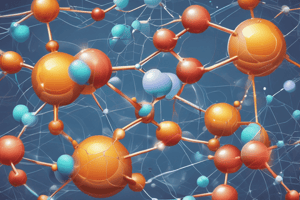Podcast
Questions and Answers
Explain how hydrogen bonding influences the boiling and melting points of water.
Explain how hydrogen bonding influences the boiling and melting points of water.
Hydrogen bonding in water creates strong attractions between molecules, resulting in high boiling and melting points compared to other similar-size molecules.
Describe the role of hydrogen bonds in the structure of DNA.
Describe the role of hydrogen bonds in the structure of DNA.
Hydrogen bonds stabilize the double helix structure of DNA by forming specific pairs between nucleotide bases (A-T and G-C).
What role do hydrogen bonds play in protein structure?
What role do hydrogen bonds play in protein structure?
Hydrogen bonds are fundamental to the formation of secondary structures such as alpha-helices and beta-sheets in proteins.
Compare the strength of hydrogen bonds to other types of intermolecular forces.
Compare the strength of hydrogen bonds to other types of intermolecular forces.
Identify the two necessary components for the formation of hydrogen bonds.
Identify the two necessary components for the formation of hydrogen bonds.
Flashcards are hidden until you start studying
Study Notes
Definition
- Hydrogen bonding is a type of dipole-dipole attraction between molecules.
- It occurs when hydrogen is covalently bonded to a highly electronegative atom (e.g., N, O, F) and experiences an attraction to another electronegative atom.
Key Characteristics
- Strength: Weaker than covalent and ionic bonds but stronger than van der Waals forces.
- Directionality: Hydrogen bonds are highly directional, influencing molecular shapes and interactions.
- Polarity: Involves polar molecules, where a partial positive charge on hydrogen is attracted to a partial negative charge on an electronegative atom.
Formation
- Requires:
- A hydrogen atom covalently bonded to an electronegative atom.
- A lone pair of electrons on another electronegative atom.
Examples
- Water (H₂O):
- Exhibits strong hydrogen bonding, leading to high boiling and melting points.
- DNA:
- Hydrogen bonds between nucleotide bases (A-T and G-C pairs) stabilize the double helix structure.
- Proteins:
- Hydrogen bonds contribute to secondary (alpha-helices, beta-sheets) and tertiary structures.
Implications
- Physical Properties: Hydrogen bonding affects boiling and melting points, solubility, and viscosity of substances.
- Biological Significance: Key in enzyme-substrate interactions, protein folding, and molecular recognition processes.
Comparison with Other Intermolecular Forces
- Stronger than: Van der Waals (London dispersion forces, dipole-dipole interactions).
- Weaker than: Ionic bonds, covalent bonds.
Summary
- Hydrogen bonding is crucial for the properties of water, biological macromolecules, and the stability of various molecular structures. Understanding hydrogen bonds is essential in fields such as chemistry, biology, and materials science.
Definition
- Hydrogen bonding is a dipole-dipole attraction between molecules.
- Occurs when hydrogen is bonded to highly electronegative atoms like nitrogen, oxygen, or fluorine, creating an attraction to other electronegative atoms.
Key Characteristics
- Strength: Weaker than covalent and ionic bonds, yet stronger than van der Waals forces.
- Directionality: Hydrogen bonds are highly directional, significantly impacting molecular shapes and interactions.
- Polarity: Involves polar molecules, where hydrogen carries a partial positive charge, attracting the partial negative charge of electronegative atoms.
Formation
- Requires a hydrogen atom covalently bonded to an electronegative atom.
- A lone pair of electrons on another electronegative atom is essential for bond formation.
Examples
- Water (H₂O): Exhibits strong hydrogen bonding, resulting in high boiling and melting points.
- DNA: Stabilizes the double helix structure through hydrogen bonds between nucleotide bases (adenine-thymine and guanine-cytosine pairs).
- Proteins: Contributes to the formation of secondary structures (alpha-helices and beta-sheets) and tertiary structures.
Implications
- Physical Properties: Influences boiling/melting points, solubility, and viscosity of substances.
- Biological Significance: Vital in enzyme-substrate interactions, protein folding processes, and molecular recognition.
Comparison with Other Intermolecular Forces
- Stronger than: Van der Waals forces, including London dispersion forces and dipole-dipole interactions.
- Weaker than: Ionic and covalent bonds.
Summary
- Hydrogen bonding plays a crucial role in the properties of water, the stability of biological macromolecules, and various molecular structures.
- Understanding hydrogen bonds is important across chemistry, biology, and materials science.
Studying That Suits You
Use AI to generate personalized quizzes and flashcards to suit your learning preferences.




